The Winning Circle Series™
Together We Win!
We have drawn inspiration from the teachings of mindfulness, clinical psychology, the physiological principles behind neuronal communication and brain dynamics, Western and Eastern religions, team and individual sports, our families, friends, and the community around us. This brought about the development of a series of educational and empowerment curriculums: The Winning Circle Series!
Our research into the creation of this program drew us deep within our past experiences, published articles and books on the concepts and issues surrounding reintegration, conferences and talking with others who have been through it all, evidence-based practices for mitigating dysfunctional behaviors, and so much more. Today, after much time carefully deciphering and piecing together how we and others have changed our lives, we believe Winning Ways will prove a boundless journey for all of those individuals we work with.
The most recent statistics on recidivism in Connecticut. Within 3 years of release, more than half of individuals had received a new arrest, new conviction, and returned to prison (1).
Our mission is to create an environment where individuals feel not forced but inspired to develop goals, create a realistic plan of action to transcend these goals, and in return motivate others to follow and achieve their dreams. We strive to develop a human-centered program with dynamics of understanding, individualized care, and guidance from those who have struggled with similar issues and overcome them in magnificent ways. Laid out hereafter is a brief summary of some aspects of our curriculum.
The winning Circle Series™ Curriculum
Financial Literacy
Evidence-based Practices
Debt Management
Investing, Saving, & Financial Planning
Paying Bills, Taxes, and Other Monetary Dues
Banking & Financial Assets
Classes for Youth & Adults
Spit and Paint
Art Programming
Winning Principles
Current Events & Peer Discussions
Cultural Diversity
Empowering Through Art
Creativity
Current Events and Peer Discussions
Elevate Your
Employment
Interest/Expertise Assessment
Power of Vision
Roadmaps
Entrepreneurship
Job Readiness
The Winning Circle Series are specially designed groups offered to anyone that is experiencing re-entry and recovery!
Our Principles
Trust & Teamwork
Integrity
Building Character
Social Equity
Community Based
Grassroots
The Winning Circle Series also includes gender-informed and age/stage of life-based services!
What Does Community Mean To You?
Prisoners leaving incarceration, “returning citizens”, or “formerly-incarcerated”? No matter how you put it, they are a part of our community. The way we as a community receive those returning from prison affects all of us. Prolonging the segregation begun with sentencing after the sentence has ended, we predispose individuals to past behaviors – not to becoming a wholesome member of society and acting in new paradigms!
It all starts with education and advocacy. As we grow and evolve over time, so will this page – continually refined based on what we experience and the growth of our true understanding. We encourage you to check back every so often and stay informed.
Click Here To Check Out Our EventsBelow are some facts and discussions regarding the state of crime and incarceration within the United States, the mechanisms behind it, and their effects.
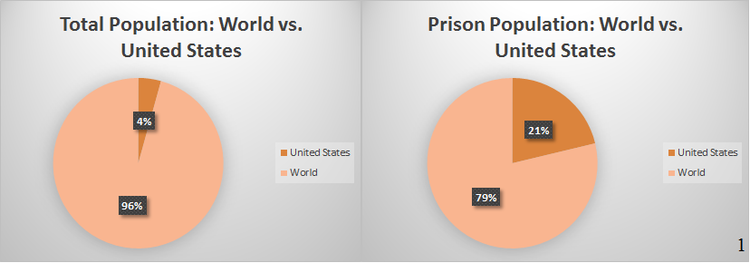
With a population of 318.9 million, the United States accounts for 4% of the 7.4 billion humans who make up our world (1). Though, of the 10.35 million prisoners held across the globe, the United States holds 2.2 million (2). As some have called it, “mass incarceration” within the United States has placed a heavy burden on society.

Drug related arrests have risen to 13% of all arrests, annually. Of all drug arrests, 82% are crimes of possession, with 18% for sale and manufacturing (3). A growing consciousness of reform, not imprisonment, when it comes to substance use must continue if we are to address this problem effectively. The proper approach to addiction: a disease encompassing a multitude of underlying factors that must be addressed.
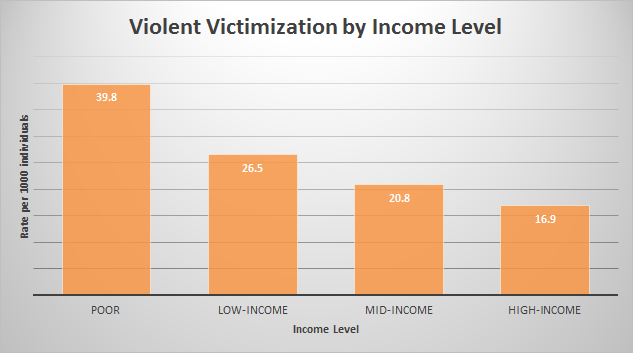
Poor – defined as 0 to 100% of the Federal Poverty Level – are two times more likely to be the victim of a violent crime than are the middle class (4). Lack of community and familial engagement, differential type and magnitude of social pressures, discrepancy in educational dynamics, and prevalence of certain themes in collective perception may play a role in this phenomenon. It is critical to consider such factors when attempting to manage such occurrences.
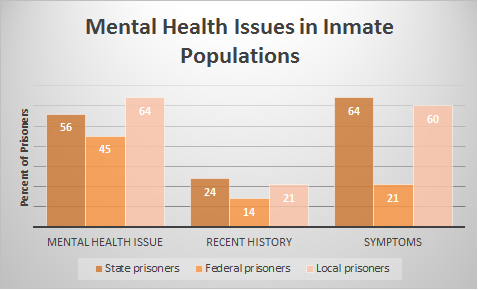
Mental health disorders are disproportionately represented in the prisoner population. The graph above shows the percentage of prisoners with a known mental health issue (left), those receiving treatment or diagnosis within 12 months of the study (center), and those displaying symptoms within 12 months of the study (right) (5).
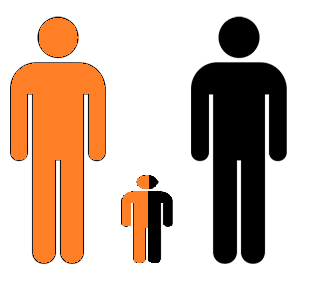
Over half of all prisoners have a child or children under the age of 18 (6). This does not account for the numerous others who have children over the age of 18. Regardless of the age, hundreds of thousands to millions of children within the United States are thus dealing with the consequences of an incarcerated parent. The psychological burdens, stigma, and disadvantages these children may encounter due to an incarcerated parent are frightening.
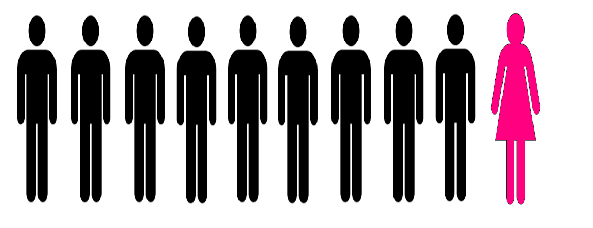
Of those prisoners with children, 92% – 9 of every 10 – are the father (6). Fatherlessness affects millions of children within the United States, putting these children at risk to develop any one of a plethora of psychological, behavioral, or learning dysfunctions. These children go on to carry the weight of fatherlessness in some form for their entire life.
A Physical Basis for Problem Behaviors
The road to recovery from the internalization of learned helplessness, overwhelmingly negative self-view, constant reinforcement of self-harming behaviors, and other dysfunctional cognitive processes is a trying one. When such processes have been enforced for years, they become extraordinarily entrenched within the identity of the individual. The entrenchment is largely due to the marked resilience of neuronal pathways.
Neuronal activation pathways can be compared to roads. The most frequently activated cognitive loops correspond to highways. When a highway is under construction, it is quite the project to remove: large teams and contractors with heavy-machinery are necessary. The process takes a substantial amount of time, often with quite a few traffic jams and setbacks along the way.
Less frequently activated pathways correspond to dirt roads and side streets. Paving over a dirt-road requires a supply of asphalt, a construction team, police to constantly redirect and manage traffic. It must be paved over by asphalt rollers when the asphalt has been laid, curated to the right width and length.
Even when the dirt road has been paved, or the side-street repaved, many drivers will still take the highway. Even if the side street next to the highway is being converted into the new highway, drivers will still take the old highway until the new one has been completed!
This is what it is like to change deep-rooted neuronal pathways. Like removing an old highway to build a new one. To reshape the themes which overlie these issues requires a powerful environment: a family – a community – which will constantly reinforce these new values we need to instill. At times, it can seem that our greatest obstacle is ourselves. By taking action, admitting faults, spiritual work and seeking help in others who would lend a hand, we believe our fellows can change. Most prisoners, and those returning from prison, weren’t born bad people – sometimes they need a second chance. By helping them along their way, those amongst us who perhaps need more help than most, we create a stronger society for everyone. A community of values, a community of trust.
Further Reading:
Citations
1. New Census Bureau Report Analyzes U.S. Population Projections. (2015, March 03). PR Newswire, p. PR Newswire, Mar 3, 2015.
2. Walmsley, R. (2016). World Prison Population List, 11th edition. London: Institute for Criminal Policy Research. Retrieved from: http://www.prisonstudies.org/sites/default/files/resources/downloads/world_prison_population_list_11th_edition_0.pdf
3. Crime in the United States 2015 – Arrests,” FBI Uniform Crime Report (Washington, DC: US Dept. of Justice, September 2016), p. 1, and Arrest Table: Arrests for Drug Abuse Violations.
4. Household Poverty and Nonfatal Violent Victimization, 2008-2012. (2014, November 18). States News Service, p. States News Service, Nov 18, 2014.
5. James, D., Glaze, L., & United States. Bureau of Justice Statistics. (2006). Mental health problems of prison and jail inmates (Rev. 12/14/06.. ed., Special report (United States. Bureau of Justice Statistics)). Washington, DC: U.S. Dept. of Justice, Office of Justice Programs, Bureau of Justice Statistics.
6. Glaze, L. & Maruschak L. (2008). Parents in prison and their minor children. (Rev. 3/30/10.. ed., Special report (United States. Bureau of Justice Statistics)). Washington, DC: U.S. Dept. of Justice, Office of Justice Programs, Bureau of Justice Statistics.

